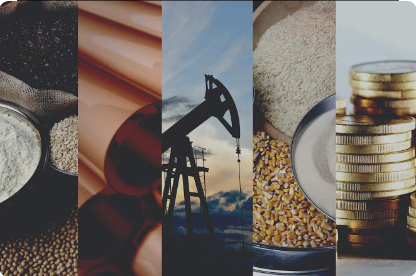The world as we knew it changed dramatically with the onset of the Coronavirus pandemic. Lockdowns, travel bans, and economic uncertainty swept across nations, sending shockwaves through global markets. Financial experts scrambled to make sense of an evolving situation that seemed to alter the landscape overnight. Among the hardest hit were commodity markets—essential sectors that play a crucial role in our daily lives.
From oil prices plummeting to agricultural production facing unprecedented challenges, understanding how these commodities have been affected is vital for investors and consumers alike. As we navigate this complex environment, it’s essential to delve into what has happened and what lies ahead for various commodities impacted by COVID-19. Join us as we explore these market dynamics and provide insights on managing investments during this tumultuous time.
Overview of Commodity Markets Affected by the Pandemic
The pandemic has left a profound mark on commodity markets worldwide. As economies faced shutdowns, the ripple effects reached far and wide. Supply chains crumbled under pressure, leading to shortages in various sectors.
Oil experienced unprecedented volatility as demand plummeted. With travel restrictions in place, fuel consumption dropped drastically. This shift sparked price wars among major producers.
Agricultural commodities also felt the strain. Lockdowns disrupted planting and harvesting schedules, affecting food supply chains globally. Consumers witnessed fluctuating prices at grocery stores as production slowed down.
Meanwhile, precious metals saw a surge in interest from investors seeking safety amidst market uncertainty. Gold prices soared while silver showed erratic movements.
Industrial metals https://finanzasdomesticas.com/materias-primas-afectadas-por-el-coronavirus faced challenges too; reduced manufacturing activity led to decreased demand for copper and aluminum significantly impacting their values over time. Each sector navigated uncharted waters during this global crisis.
Oil Market: Supply and Demand Dynamics, Price Fluctuations, and Future Outlook
The oil market https://finanzasdomesticas.com/materias-primas-afectadas-por-el-coronavirus has experienced dramatic shifts due to the pandemic. As lockdowns spread, demand plummeted almost overnight. Airlines grounded planes, and vehicles stayed parked.
This sudden drop in consumption led to a surplus of crude oil, pushing prices down significantly. At one point, futures contracts even fell into negative territory for the first time in history.
As economies began reopening, demand rebounded but not without complications. OPEC+ countries have made efforts to stabilize prices by reducing production levels. Yet with global recovery being uneven, uncertainty looms.
Looking ahead, experts are divided on where oil prices will land. Some predict a steady climb as travel resumes while others warn of potential new variants disrupting markets again. This complex landscape makes forecasting particularly challenging for investors navigating these turbulent waters.
Agricultural Commodities: Effects of Lockdowns and Trade Restrictions on Production and Consumption
The pandemic significantly disrupted agricultural commodities, impacting both production and consumption. Lockdowns halted farming activities and restricted labor availability. Farmers faced challenges in planting and harvesting crops on time.
Trade restrictions https://finanzasdomesticas.com/materias-primas-afectadas-por-el-coronavirus further complicated the scenario. Export bans by some countries created shortages in others, leading to price volatility. Many nations scrambled to secure essential food supplies amid growing fears of scarcity.
Consumer behavior shifted dramatically as well. Panic buying led to temporary spikes in demand for staples like rice and flour, while luxury products saw a decline. This mismatch resulted in waste for perishable goods that couldn’t reach markets quickly enough.
Supply chains faced unprecedented strain, affecting everything from logistics to pricing strategies. The ripple effects continue to influence market dynamics as stakeholders adapt to this new reality.
Precious Metals: Safe Haven Investment or Volatile Market?
Precious metals have long been viewed as a safe haven for investors. Gold and silver, in particular, tend to retain value amid economic turmoil. Their allure often stems from their historical role as currency and their inherent scarcity.
However, the pandemic introduced volatility into these once-stable markets. Prices surged initially due to heightened demand for security. Yet fluctuations became common as market dynamics shifted rapidly.
Additionally, investor sentiment plays a crucial role here. In uncertain times, some flock to precious metals while others pivot towards stocks or cryptocurrencies when optimism returns.
The outlook remains mixed; geopolitical tensions and inflation fears can propel prices upward again. Still, the unpredictable nature of global events makes forecasting challenging at best.
As investors weigh options in this landscape, understanding both risks and rewards is vital.
Industrial Metals: The Slow Road to Recovery as Manufacturing Takes a Hit
The pandemic has cast a long shadow over the industrial metals market. With factories shuttered and supply chains disrupted, demand for these essential materials plummeted.
Copper, aluminum, and nickel faced significant price drops as construction projects stalled. The ripple effect was felt across various sectors reliant on these resources. Manufacturers scrambled to adjust their operations amid ongoing uncertainty.
As economies begin to reopen, a slow recovery is underway. However, challenges remain. Labor shortages and transportation bottlenecks are complicating the rebound process.
Despite hurdles, there’s cautious optimism in certain markets like green technology. As governments invest in renewable energy initiatives, demand for metals used in solar panels and electric vehicles could rise.
Investors must stay vigilant about fluctuating prices while considering longer-term trends that might influence recovery trajectories within this crucial sector.
Strategies for Managing Investments in
Navigating the complexities of commodity markets during and after the pandemic requires strategic planning. Investors should consider diversifying their portfolios to mitigate risks associated with volatility in specific sectors. Keeping an eye on global economic indicators can provide insight into potential market shifts.
Staying informed about government policies, trade agreements, and local production capabilities is crucial for making educated decisions. Creating a balanced investment strategy that includes both traditional commodities and emerging alternatives may also help cushion against unexpected downturns.
Moreover, it’s wise to consult financial experts who specialize in commodities to tailor strategies that align with personal risk tolerance and financial goals. With careful management and foresight, investors can better position themselves for recovery as the world adjusts to new realities shaped by the pandemic’s lasting effects.

